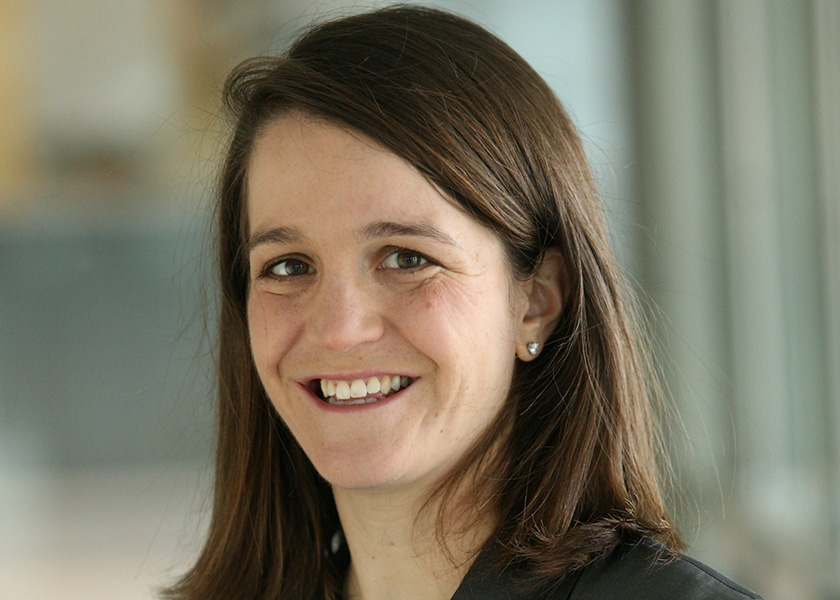Tackling the Grand Challenges in Human Computer Interaction + Design
Panelists discussed systemic obstacles and shared perspectives on their transition from academia to industry

Grand challenges are formidable problems that cross disciplinary boundaries and span sectors of industry. And the fields of Human Computer Interaction and Design face many grand challenges that impact the way we live our day-to-day lives going forward.
“The global scale and complexity of these challenges demands interdisciplinary expertise and collaboration between industry and academia,” said Elizabeth Gerber, professor of mechanical engineering and (by courtesy) computer science at Northwestern Engineering, and professor of communication studies in Northwestern’s School of Communication.
Gerber is co-director of the Center for Human-Computer Interaction + Design (HCI+D), a collaboration between the McCormick School of Engineering and the School of Communication. Launched in 2020, the center seeks to study, design, and develop the future of human and computer interaction at home, work, and play through interdisciplinary research in areas including better health, collaborative computing, data visualization, human-centered AI, and inclusive computing.

On November 4, HCI+D and the Technology and Social Behavior program convened a panel of leaders to discuss the grand challenges in industry, the skills required to address these challenges, and how academia and industry might work together toward solutions. Gerber moderated the virtual event, which drew more than 125 attendees.
The five panelists, all Northwestern alumni, shared the most pressing systemic obstacles occupying their thoughts. The theme of broadening participation quickly emerged as a throughline.
Mark Diaz (PhD ’20), a team research scientist on Google’s Ethical AI team, identified the challenge of broadening participation in the creation of algorithmic systems and large language models. Diaz highlighted a community-based intern project piloted last summer in Chicago as an example of how his team is working to broaden both cross-disciplinary participation and user participation.
“Ultimately you’re trying to get perspectives from people that are going to be using the systems or are otherwise impacted stakeholders because their data is part of the datasets we use in systems at scale,” Diaz said.
Isaac Johnson (PhD ’19) discussed the grand challenge of language equity. Johnson is a research scientist at Wikimedia Foundation, which currently supports more than 300 language communities. Johnson tackles design and HCI questions such as: What language communities are included in computational social science research projects? What languages are machine learning engineers designing natural language models to support? And which language community problems are we prioritizing to support?
“The language you speak shouldn’t be a barrier to accessing knowledge and tools,” Johnson said, “but obviously right now it very much is.”
Lauren Scissors (PhD ’13), director of research at Facebook, focused on the task of systematic, scalable methods to build features, products, and applications that ensure positive and meaningful experiences for user groups.
“It’s just impossible to think about every particular group of people and make sure all of their needs are served,” she said, “but we can’t just throw our hands up in the air and say, ‘Oh well, we’ll just ignore that.’”
Scissors worked on developing the original set of Facebook reactions to solve a user need for greater range of expression. Her team conducted specific useability research as well as more abstract, emotion-based research. The group’s work involved consulting academic literature, running testing in multiple countries on state-of-the-art platforms, and collaborating with designers, product managers, engineers, and data scientists.
The panelists also discussed the business case and industry incentives (or lack thereof) for tackling fundamental problems, overcoming naysayers, and common misperceptions related to issues such as scaling and expanding access.
Emily Harburg (PhD ’18), noted that her team is discussing how to improve online accessibility for customers who are blind or low vision and people who are deaf or hard of hearing. Harburg is director of emerging technology and innovation at EF Education First, an international education company.
“It’s hugely important for the company to be able to serve those audiences. Those are the best scenarios: when it’s actually good for society and positive for business,” said Harburg, who also co-founded Brave Initiatives, a nonprofit focused on helping women build confidence in coding, design, and leadership. “By focusing on populations who are not fully represented, we’re able to serve and support so many more people.”
The industry learning curve
The speakers also shared insights into their transition from academia to industry.
Prem Seetharaman (PhD ’19) recalled his initial blue-sky mentality toward research upon joining industry and then shifting gears to a more product-focused lens. Seetharaman is a research scientist at Descript, a company that builds collaborative tools for media creators.
“I really wanted to solve problems that industry simply is not incentivized for, especially at a startup for example, the pace of research is much more geared toward product and solving some little problems versus big problems,” Seetharaman said. “The one thing that really helped to change my mindset was to realize that little problems add up to a big result.”
Scissors reflected on the learning curve involved in understanding how products are designed and built and the constraints and motivations of industry decision making. She noted that she regularly invites academics to work alongside her team to problem-solve and exchange ideas.
A call to action
Gerber closed the event by asking the panelists to offer guidance and action items for the audience.
Scissors stressed that there is no substitute for high-quality research.
“When you do research well, that means you can rely on the insights, and when you can rely on the insights, it means you can really make good decisions,” Scissors said.
“Develop a unique style and a unique way of tackling problems. At the end of the day, what you bring to the table is your perspective on things,” Seetharaman said. “It takes a lot of minds to solve these hard problems.”
Diaz advised building communication skills to articulate research and problem-solving to diverse audiences outside of academia. He recalled the benefit he received from a Northwestern Center for Civic Engagement seminar framed around public scholarship and the core question: How do you communicate with people outside of academia?
“You have important knowledge and questions you’re researching for broader communities, so those broader communities should have an access point to those conversations,” Diaz said.